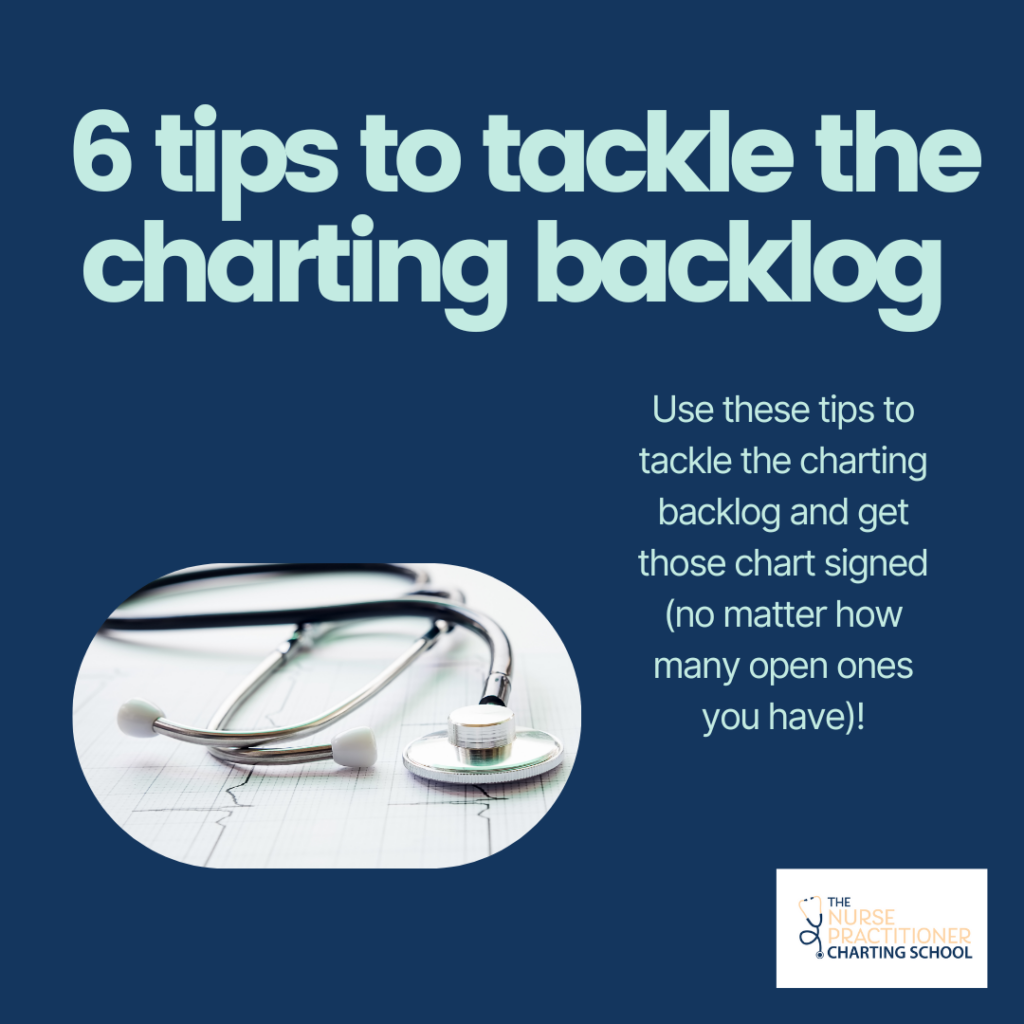Are you a nurse practitioner overwhelmed by a charting backlog? Do you have a large amount of open charts from past patient visits? Are you constantly digging yourself into a bigger hole with no sign of relief?
A charting backlog is any amount of open charts that nurse practitioners have not yet signed off/completed. When a nurse practitioner sees a patient in an outpatient, inpatient, emergency, or skilled nursing facility setting, they are responsible for completing a chart note.
The nurse practitioner will intake information, assess, diagnose, and treat the patient. The APRN will then document the information into a chart note. These chart notes should be signed off in a timely manner to ensure accuracy of information.
The documentation is then assigned an evaluation and management code which is used to bill the patient’s insurance. The chart note may also be reviewed by other medical providers, especially if the patient follows-up or a referral to a specialty provider is completed.
The charting backlog
With the amount of patients a nurse practitioner sees a day, along with the “other tasks” (i.e. addressing medication refills, reviewing past medical documentation, analyzing diagnostic data, and the never ending patient messages), it is very common for the amount of open charts to pile up. This creates a charting backlog.
Here is an article further discussing the burden of charting backlog.
But as The Nurse Practitioner Charting Coach, I want to share some tips for overcoming and managing a charting backlog. It is my mission and passion to help nurse practitioners avoid staying late at the office or bringing charts home. I want to help nurse practitioners create a better work-life balance and overcome nurse practitioner burnout.
However, I need to also give you some tough love. If you have a large amount of open charts, you NEED to make a change. There is something in your professional life that is currently not working. Address what that is and conquer it! Then utilize these tips to conquer the charting backlog and get your time back!
Tackle the charting backlog
Give yourself grace.
The first thing I want you to do is give yourself some grace for having a charting backlog. Nurse practitioners have incredibly overwhelming jobs with multiple tasks. The work takes a mental, emotional, and physical toll on us. We spend so much time and energy completing our work. It is so easy to fall behind as the charts pile up.
If you currently have a charting backlog (no matter if it’s 5 open charts or 125), don’t beat yourself up! Give yourself some grace and understanding! If you implement the other charting tips below and address the charting backlog, it will improve.
Set a goal.
With a large number of open charts, it can feel overwhelming to get all of the charts signed. Try breaking the overall number into small, bite sized goals. For example, if you have 50 open charts, set a goal to get 5 signed off each day. Over the next 10 days, you will have the charting backlog complete!
When we have a large task at stake, our brains can become overwhelmed and start to shut down. But when we break the charting backlog into smaller, more attainable goals, it is easier to get the charts signed off.
Ask for more time.
Ask the clinic manager or administrator for additional time to be blocked off in order to catch up on charting. Think of how many charts you could get signed off when you have one hour a day where you can solely focus on catching up on the charting backlog. Maybe you can ask for the first hour of the day to be dedicated to signing off any open charts.
From a business standpoint, the clinic manager or administrator knows that charts need to be signed off in a timely manner in order to bill the patient’s insurance. There is a time frame (usually 90 days) that claims need to be submitted. For example, if you see a patient, you have X amount of days before an insurance company will no longer accept that claim.
Open charts can also bring a liability to the clinic. If something were to happen to that patient and the previous chart note was not signed off until after the incident, it could raise some concern. That is why it is so important to address the charting backlog and why many clinic managers or administrators are open to providing additional time for nurse practitioners to sign off notes.
Try not to get behind on current charts.
One of the challenges nurse practitioners face when addressing the charting backlog is not getting behind on their current work. There is a reason the NP is faced with a large amount of open charts in the first place.
Insurmountable amount of patients seen in a work day, additional “other tasks” (medication refills, analyzing diagnostic data, reviewing past medical documentation, never ending patient messages). It is very easy to fall behind with a large amount of open charts.
But the first step is for nurse practitioners to improve their charting and not get further behind. Implement charting tips (discussed below) in order to get charts signed off right after the patient encounter. Work on improving your charting and tackling the current open charts.
Yes, signing off on the open charts is important, but you will be spinning your wheels if you only focus on the charting backlog. I encourage nurse practitioners to focus on their current workload and improve this first. Then they can be current with their charting and be able to tackle the charting backlog.
Addressing the EHR inbox.
One of the biggest roadblocks of getting charts signed is the never-ending amount of tasks within the electronic health record inbox. Most charting systems have an “inbox” that nurse practitioners have to address. Within the inbox contains medication refills, diagnostic data to analyze, past medical documentation to review, and the never ending patient messages.
Addressing the EHR inbox takes a lot of the nurse practitioner’s time and energy which can lead to a large charting backlog. But there are a few things I recommend nurse practitioners implement to help save time.
I want APRNs to set (and keep) boundaries when it comes to patient messages. Patients should schedule an appointment instead of asking medical advice or getting treatment recommendations over the patient messages. You can utilize smart phrases for a generic response encouraging nurse practitioners to schedule an appointment in the clinic. Delegate tasks to support staff can be helpful and takes less time away from the nurse practitioner.
***Here are some additional resources to improve the process of the EHR inbox.
6 tips to manage patient messages.
4 tips to manage the EHR inbox as nurse practitioners.
Additional charting tips.
The Nurse Practitioner Charting School has so many charting resources to offer! As a Nurse Practitioner Charting Coach, I help nurse practitioners improve their charting so they can stay on time during the workday, no longer stay late to chart, and STOP bringing their charts home! I will touch on a few charting tips in the article, but I strongly encourage nurse practitioners to check out The Nurse Practitioner Charting School for additional charting tips!
1. Creating problem focused chart notes. Many nurse practitioners tend to create note bloat. They write very comprehensive, detailed chart notes that take more time and energy to write. I recommend nurse practitioners focus on creating problem focused chart notes.
Documentation should be straight to the point and not a lot of extra “fluff” this is true from a time management, billing/coding, and legal perspective. Work on creating problem focused chart notes in order to address the charting backlog.
2. Using smart phrases. I always recommend to utilize smart/dot phrases when charting. This is why I put together the Comprehensive List of Smart Phrases. Smart phrases (also known as dot phrases) are commonly used words or phrases.
If you find yourself constantly typing out the same thing (i.e. history of present illness, physical exam, plan of care instructions) then make it into a smart phrase! Smart phrases will help you save so much time charting, freeing up your time to address the charting backlog.
3. Implementing virtual scribe services. Some facilities are exploring the use of scribe services, where trained individuals assist nurse practitioners in documenting patient encounters. This approach can alleviate the burden of documentation and allow NPs to concentrate on direct patient care.
While this does not directly help APRNs address the charting backlog, it does help them to keep up with current charts. This allows nurse practitioners to get their charts signed quicker so they have more time and energy to address the charting backlog.
*** If you would like more information about virtual scribes, I have partnered with ScribeEMR, a virtual scribes company! Send me an email and I can connect you with a representative from ScribeEMR
As mentioned, it does not take much to get behind on charting. Nurse practitioners have incredibly overwhelming and busy jobs, it is hard to stay caught up. So if you are a nurse practitioner with a large number of open charts and a charting backlog, don’t feel bad! It will take some work to get through the charts but if you implement the charting tips discussed through The Nurse Practitioner School, you will soon be caught up on work, eliminating the charting backlog!

Erica D the NP is a family nurse practitioner and The Nurse Practitioner Charting Coach. Erica helps nurse practitioners STOP charting at home! Erica created The Nurse Practitioner Charting School to be the one stop for all documentation resources created specifically for nurse practitioners. Learn more at www.npchartingschool.com
Follow on Facebook: The Nurse Practitioner Charting SchoolAnd on Instagram: @npchartingschool
Free training: 4 charting tips to help nurse practitioners get their time back! Sign up here!



